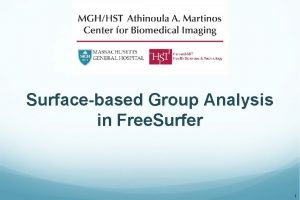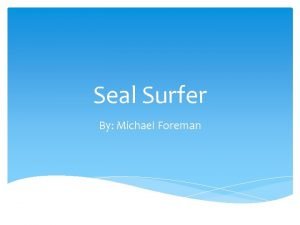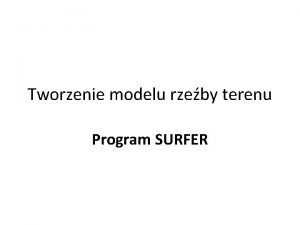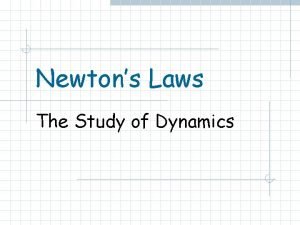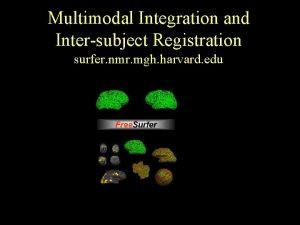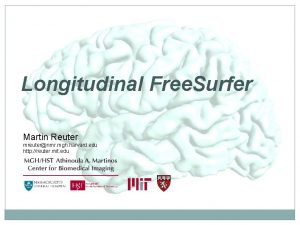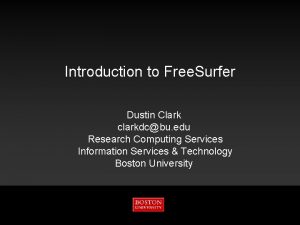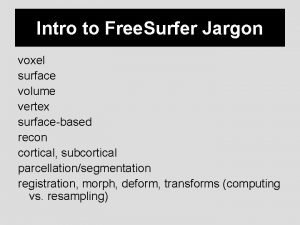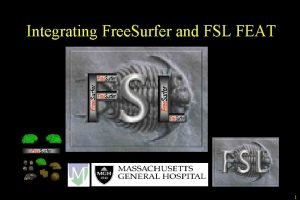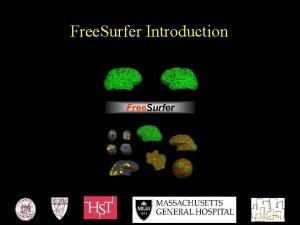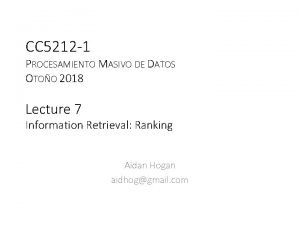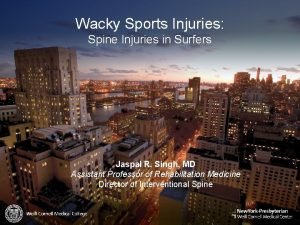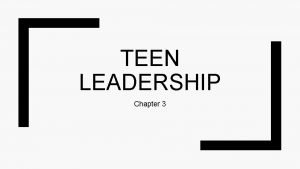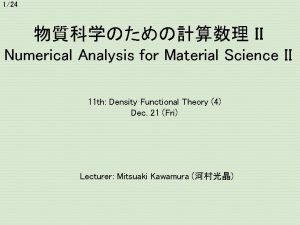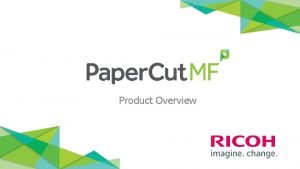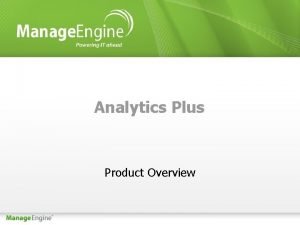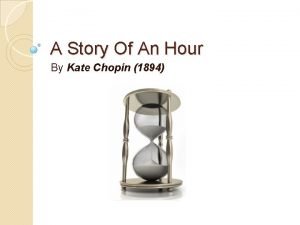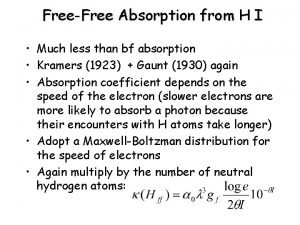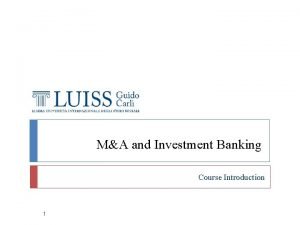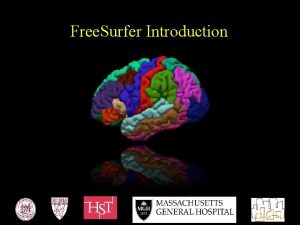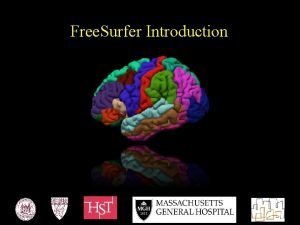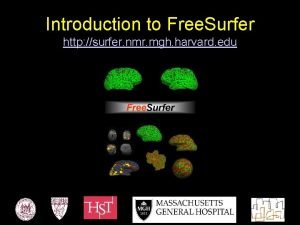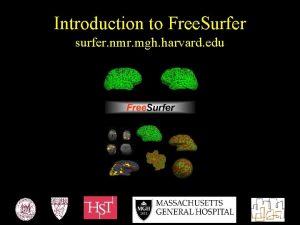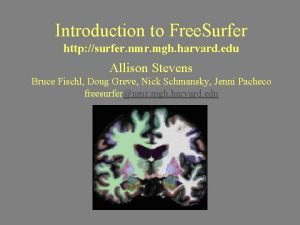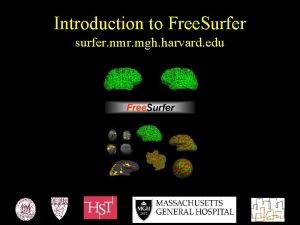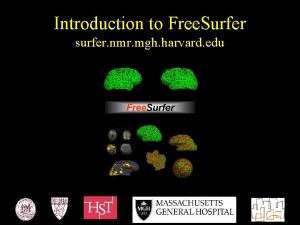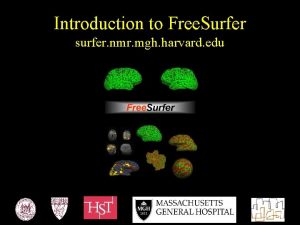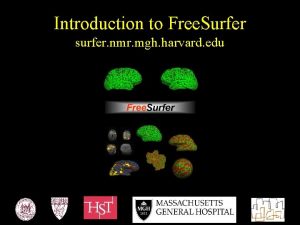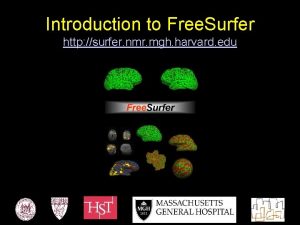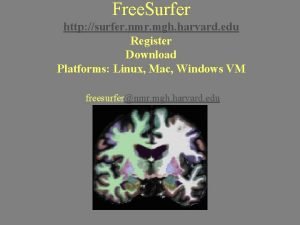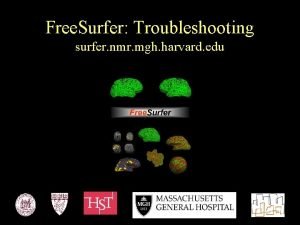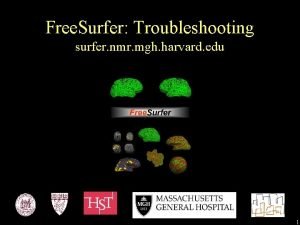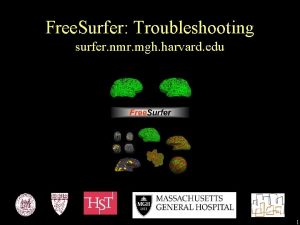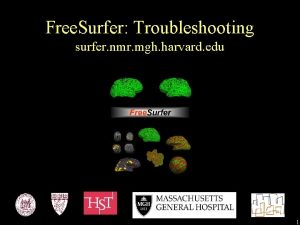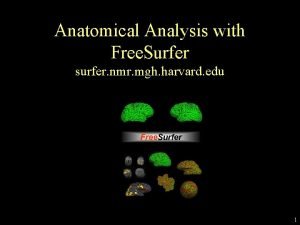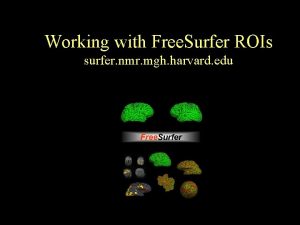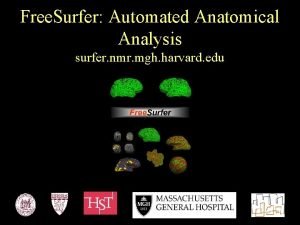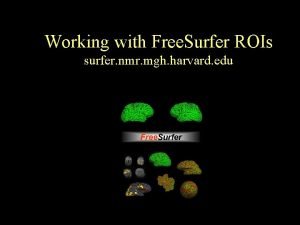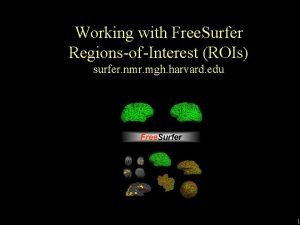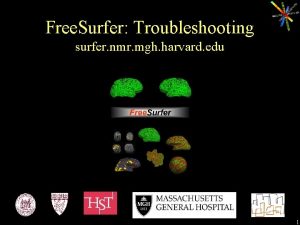Free Surfer Introduction Course Overview Day 1 Introduction



















































- Slides: 51

Free. Surfer Introduction

Course Overview Day 1 – Introduction – Individual Subject Analysis – ROI Analysis Day 2 – Group Analysis – Troubleshooting – Longitudinal Analysis Day 3 – Multimodal Analysis – Diffusion Analysis – f. MRI Analysis – MR Basics Day 4 – f. MRI Analysis – Multimodal Analysis – Future Directions

Course Schedule https: //surfer. nmr. mgh. harvard. edu/fswiki/Fs. Tutorial/October 2018 Course. Schedule

Lectures and Practicals • General format: talk followed by tutorial (both are on the wiki course page, but please don’t download tutorial data or Free. Surfer– it can kill the network) Note about tutorials: we have many people with different background who will help. Whoever comes over first will either be able to answer your question(s), or will find someone who can Search on You. Tube for the Free. Surfer channel!

Food and such Cafeteria in main building (Building 149) Morning coffee and “breakfast” – muffins, bagels, fruit Afternoon coffee and some snacks Tuesday evening socializing at Boston Beer Works

To Caffeinate or not to Caffeinate? Please don’t spill coffee (or anything else!) on the laptops. If you do, please be prepared to fund a replacement!

Post Your Questions! http: //surfer. nmr. mgh. harvard. edu/cgi-bin/fsurfer/questions. cgi

Search for Answers

What Is Free. Surfer? Inflation Surface Mesh E D Group Template Surface ROI J Curvature C Sphere F Individual T 1 I Spatial Normalization A A Surface Extraction Thickness B G Deformation Field H 2 mm 4 mm Apply Deformation Volume ROI O Statistical Map N M p<. 01 Group Analysis L K Smooth p<. 01 Other Subjects Thickness (Group Space)

What is Free. Surfer? Total # licenses distributed as of Halloween, 2017 (over 36, 000 by Aug, 2018)

Outline • A Brief History of Free. Surfer • What are Surfaces Good For Anyway? • Inferring Microstructural Locations • Longitudinal Analysis • DWI/Tractography • f. MRI

Free. Surfer began life as a means for EEG/MEG Analysis Citations Improved localization of cortical activity by combining EEG and MEG with MRI cortical surface reconstruction: a linear approach. AM Dale, MI Sereno. Journal of cognitive neuroscience 5 (2), 162 -176, 1994. 1736 Dynamic statistical parametric mapping: combining f. MRI and MEG for high 1212 resolution imaging of cortical activity. AM Dale, AK Liu, et al, Neuron 26 (1), 55 -67, 2000.

How To Model The Pial Surface? (an unanswered question circa 1996)

Inferring the Location of the Pial Surface Key Insight (Anders’ and Marty’s, not mine): Model the gray/white boundary and use it to infer pial surface locations Citations Cortical surface-based analysis: I. Segmentation and surface reconstruction. AM Dale, B Fischl, MI Sereno, Neuroimage 9 (2), 179 -194. 1999. 5675 Cortical surface-based analysis: II: inflation, flattening, and a surface-based coordinate system. B Fischl, MI Sereno, AM Dale Neuroimage 9 (2), 195 -207. 1999. 4072

Inferring the Location of the Pial Surface Key Insight (Anders’ and Marty’s, not mine): Model the gray/white boundary and use it to infer pial surface locations Citations Cortical surface-based analysis: I. Segmentation and surface reconstruction. AM Dale, B Fischl, MI Sereno, Neuroimage 9 (2), 179 -194. 1999. 5675 Cortical surface-based analysis: II: inflation, flattening, and a surface-based coordinate system. B Fischl, MI Sereno, AM Dale Neuroimage 9 (2), 195 -207. 1999. 4072 My Favorite Review: “In the method section alone, scholarship is lacking, the notation is incorrect and misleading and even a basic understanding of elementary topology is lacking…

Inferring the Location of the Pial Surface Key Insight (Anders’ and Marty’s, not mine): Model the gray/white boundary and use it to infer pial surface locations Citations Cortical surface-based analysis: I. Segmentation and surface reconstruction. AM Dale, B Fischl, MI Sereno, Neuroimage 9 (2), 179 -194. 1999. 5675 Cortical surface-based analysis: II: inflation, flattening, and a surface-based coordinate system. B Fischl, MI Sereno, AM Dale Neuroimage 9 (2), 195 -207. 1999. 4072 My Favorite Review: “In the method section alone, scholarship is lacking, the notation is incorrect and misleading and even a basic understanding of elementary topology is lacking… That said, this is by far the strongest section of the paper”

Free. Surfer: Surface-based modeling challenges One wants a topologically correct model (no handles or holes) so that (1) distances along the surface aren’t dramatically distorted, and (2) it is possible to establish point-to-point registration across subjects for every point in the cortex, but…. The only technique to guarantee topology at the time was “shrink wrapping” in which you start with a surface of the correct topology (a sphere) and try to deform it so it settles on the true pial surface. The problem is that shrink wrapping a highly-folded surface like the human brain is HARD!.

How To Get The Topology Right?

Why Shrink wrapping is Hard!

Shrink Wrapping

Topology Correction

Topology Correction via Manifold Surgery BEFORE AFTER

Problems with Affine (12 DOF) Registration Subject 1 Subject 2 aligned with Subject 1 (Subject 1’s Surface)

A Surface-Based Registration Common space for group analysis (like Talairach) “fsaverage”

Topology Correction and Spherical Averaging Citations High-resolution intersubject averaging and a coordinate system for the cortical surface. B Fischl, MI Sereno, RBH Tootell, AM Dale. Human brain mapping 8 (4), 272 -284, 1999. 2174 Automated manifold surgery: constructing geometrically accurate and topologically correct models of the human cerebral cortex. B Fischl, A Liu, AM Dale, IEEE transactions on medical imaging 20 (1), 70 -80, 2001. 1152 My Second Favorite Review. We intended to submit equations like:

Topology Correction and Spherical Averaging Citations High-resolution intersubject averaging and a coordinate system for the cortical surface. B Fischl, MI Sereno, RBH Tootell, AM Dale. Human brain mapping 8 (4), 272 -284, 1999. 2174 Automated manifold surgery: constructing geometrically accurate and topologically correct models of the human cerebral cortex. B Fischl, A Liu, AM Dale, IEEE transactions on medical imaging 20 (1), 70 -80, 2001. 1152 My Second Favorite Review. Incorrect printer fonts turned them into: = ♠♣♥♦

Topology Correction and Spherical Averaging Citations High-resolution intersubject averaging and a coordinate system for the cortical surface. B Fischl, MI Sereno, RBH Tootell, AM Dale. Human brain mapping 8 (4), 272 -284, 1999. 2174 Automated manifold surgery: constructing geometrically accurate and topologically correct models of the human cerebral cortex. B Fischl, A Liu, AM Dale, IEEE transactions on medical imaging 20 (1), 70 -80, 2001. 1152 My Second Favorite Review: “” = ♠♣♥♦

And Finally, the Aseg Citations Whole brain segmentation: automated labeling of neuroanatomical structures in the human brain. B Fischl, DH Salat, et al. , Neuron 33 (3), 341 -355. 2002 Sequence-independent segmentation of magnetic resonance images. B Fischl, DH Salat, et al. , Neuroimage 23, S 69 -S 84, 2004. The aseg was the final piece that let us totally automate the processing. 4454 1305 Cortex Lateral Ventricle White Matter Thalamus Caudate Pallidum Hippocampus Putamen Amygdala

Outline • A Brief History of Free. Surfer • What are Surfaces Good For Anyway? • Inferring Microstructural Features • Longitudinal Analysis • DWI/Tractography • f. MRI

What Can One Do With A Surface Model? goal: use model to imposed desired activity pattern on V 1 desired shape of activity pattern required shape of stimulus w=k log(z+a) left primary visual cortex right visual hemifield Collaboration with Jon Polimeni and Larry Wald.

Tangential Resolution Measured with Surface-based Analysis Collaboration with Jon Polimeni and Larry Wald. Polimeni, et al, 2010, NI.

Tangential Resolution Measured with Surface-based Analysis Collaboration with Jon Polimeni and Larry Wald. Polimeni, et al, 2010, NI.

Neuro. Marketing! Aim 1 of our NCRR Center Grant, spelling: “MGH Center for Functional Neuroimaging Technologies; and NCRR Center for Research Resources. ” (just kidding) Thanks to Larry Wald for this slide.

Outline • A Brief History of Free. Surfer • What are Surfaces Good For Anyway? • Inferring Microstructural Locations • Longitudinal Analysis • DWI/Tractography • f. MRI

Surface-based Registration Performance Brodmann, 1909

Predicting Brodmann Areas: Talairach Coordinates 10 subjects overlap 1 subject overlap BA 17 (V 1) (Amunts et al, 2000, 2004) BA 18 (V 2) BA 44 (Broca’s) BA 45 (Broca’s)

Predicting Brodmann Areas from Folding Patterns BA 17 (V 1) 0% BA 44 BA 18 (V 2) 100% Overlap BA 45 Fischl, et al, 2007. Thanks to Katrin Amunts, Karl Zilles and Hartmut Mohlberg for the data, and to Niranjini Rajendran and Evelina Busa for the analysis.

Ex vivo MRI of hippocampal subfields Resolution as high as 0. 1 mm isotropic Allows precise manual tracing of hippocampal subfields. The delineation only relies on geometry for subdividing the CA. Joint work with J. Eugenio Iglesias, Koen van Leemput and Jean Augustinack

Automated Segmentation We use the atlas as a prior, and connect it to the image through a Gaussian likelihood term for each label. This makes the segmentation sequence-independent. 0. 6 mm isotropic T 1 (Winterburn et al. ) 1 mm T 1 + 0. 4 x 2 mm T 2 (ADNI) Joint work with J. Eugenio Iglesias, Koen van Leemput and Jean Augustinack

Outline • A Brief History of Free. Surfer • What are Surfaces Good For Anyway? • Inferring Microstructural Locations • Longitudinal Analysis • DWI/Tractography • f. MRI

Robust Registration Target Reuter et al, 2010 Neuro. Image Target

Robust Registration Registered Src correlation ratio Reuter et al, 2010 Neuro. Image Registered Src Robust

Longitudinal Processing 1. Create unbiased subject template (iterative registration to median) 2. Process template 3. Initialize time points 4. Let it evolve there Reuter et al. OHBM 2010, Neuro. Image 2011 & 2012 Avoid Bias: All time points are treated the same Increases sensitivity and reliability!

Outline • A Brief History of Free. Surfer • What are Surfaces Good For Anyway? • Inferring Microstructural Locations • Longitudinal Analysis • DWI/Tractography • f. MRI

Tractography with TRACULA (TRActs Constrained by the Underlying Anatomy) • Completely automated modeling of 18 major fascicles • Uses prior probabilistic information on the anatomical structures that each fascicle goes through or next to Collaboration with Anastasia Yendiki, Lilla Zöllei, Saad Jbabdi, Tim Behrens and Jean Augustinack

Outline • A Brief History of Free. Surfer • What are Surfaces Good For Anyway? • Inferring Microstructural Locations • Longitudinal Analysis • DWI/Tractography • f. MRI

Sampling on the Surface 15 sec ‘ON’, 15 sec ‘OFF’ • Flickering Checkerboard • Auditory Tone • Finger Tapping

Spatial Smoothing • 5 mm apart in 3 D • 25 mm apart on surface! • Kernel much larger • Averaging with other tissue types (WM, CSF) • Averaging with other functional areas

Group f. MRI Analysis: Volume vs Surface Affine registration to MNI 305 5 mm volume smoothing vs. 10 mm surface smoothing

What is Free. Surfer? • • • Cortical extraction and labeling Subcortical Segmentation Surface-based Inter-subject Registration Fully automated Multi-modal integration Use Free. Surfer Be Happy

Why Should I Use Free. Surfer? Please do not try this yourself without expert supervision – it can be extremely dangerous!
 Day 1 day 2 day 3 day 4
Day 1 day 2 day 3 day 4 Free surfer
Free surfer Seal surfer
Seal surfer Day 1 day 2 day 817
Day 1 day 2 day 817 Surfer program
Surfer program A surfer hangs ten and accelerates
A surfer hangs ten and accelerates Surfer
Surfer Reuter
Reuter Surfer
Surfer Free
Free Tksurfer
Tksurfer Surfer
Surfer Surfer
Surfer Random surfer model
Random surfer model Surfer myelopathy
Surfer myelopathy Interpersonal skills in soul surfer
Interpersonal skills in soul surfer Fermisurfer
Fermisurfer Fermi surfer
Fermi surfer Header bond t junction
Header bond t junction Course title and course number
Course title and course number Chaine parallèle muscle
Chaine parallèle muscle What is bioinformatics an introduction and overview
What is bioinformatics an introduction and overview Papercut job tickerting print software
Papercut job tickerting print software Introduction product overview
Introduction product overview Introduction product overview
Introduction product overview Introduction product overview
Introduction product overview Gibbs free energy spontaneous
Gibbs free energy spontaneous How to calculate gibbs free energy
How to calculate gibbs free energy Coupled reaction
Coupled reaction Allocating kernel memory in os
Allocating kernel memory in os Helmholtz free energy and gibbs free energy
Helmholtz free energy and gibbs free energy Free hearts free foreheads
Free hearts free foreheads That was then this is now summary
That was then this is now summary Free free absorption
Free free absorption Free book day
Free book day Pgcps calendar a day b day
Pgcps calendar a day b day Haiku and
Haiku and Day to day maintenance
Day to day maintenance Physical science chapter 6 review answers
Physical science chapter 6 review answers Tomorrow i don't know
Tomorrow i don't know What happened sunday in romeo and juliet
What happened sunday in romeo and juliet Growing day by day
Growing day by day Observation of seed germination day by day
Observation of seed germination day by day Seed germination conclusion
Seed germination conclusion Observation of plant growth day by day
Observation of plant growth day by day I live for jesus day after day
I live for jesus day after day Oh glorious day
Oh glorious day Day one day one noodle ss2
Day one day one noodle ss2 Dayone ss2
Dayone ss2 Introduction to banking course
Introduction to banking course Imbe introduction course v2
Imbe introduction course v2 Introduction to software engineering course outline
Introduction to software engineering course outline

